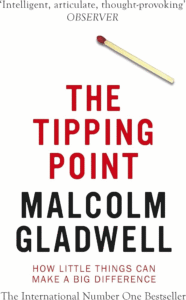Understanding the Ripple Effect: An Analysis of Malcolm Gladwell’s The Tipping Point

The Genesis of Epidemics
Malcolm Gladwell’s The Tipping Point: How Little Things Can Make a Big Difference is not merely a book; it is a lens through which to understand the often-mystifying spread of social phenomena, trends, and ideas. Published in 2000, Gladwell’s seminal work introduced the concept of the “tipping point” – that magical moment when an idea, trend, or social behavior crosses a threshold, tips, and spreads like wildfire. Far from being random or inexplicable, Gladwell argues that such outbreaks follow predictable patterns, driven by a few key agents and conditions. At its core, The Tipping Point dissects the mechanisms of epidemics, be they fashion trends, crime waves, or the adoption of new technologies.
The Law of the Few: The Architects of Change
Gladwell identifies three fundamental rules that govern these outbreaks: the Law of the Few, the Stickiness Factor, and the Power of Context. The Law of the Few posits that the success of any epidemic is disproportionately dependent on the efforts of a small number of exceptional people. These individuals are categorized as Connectors, Mavens, and Salesmen. Connectors are the social glue, possessing a vast network of acquaintances and an innate ability to bring people together. Mavens are information specialists, hoarders of knowledge who love to share what they know. Salesmen, with their irresistible charisma and persuasive power, are masters of conveying messages and making them stick. Gladwell provides compelling examples of each, from Paul Revere’s legendary ride, which wasn’t merely a solo act but a networked effort, to the contagious spread of Hush Puppies shoes, attributed to a handful of fashion-forward individuals.
The Stickiness Factor: Crafting Memorable Messages
Beyond the influence of these specific personality types, Gladwell emphasizes the crucial role of the message itself, introducing the Stickiness Factor. This refers to the ability of a message or idea to be memorable and impactful enough to incite action. He explores how seemingly minor alterations in the presentation of information – from the format of children’s television shows like Sesame Street to the design of public health campaigns – can dramatically increase their effectiveness. The stickiness of a message determines whether it merely registers or truly resonates, prompting individuals to adopt a new behavior or embrace an idea. A message that sticks is one that is not only heard but also understood and retained, thereby becoming a catalyst for change.
The Power of Context: Environment as a Catalyst
Finally, Gladwell highlights the profound influence of environment and circumstance with the Power of Context. This rule asserts that human behavior is far more sensitive to context than we often realize. He illustrates this with the drastic reduction in crime in New York City during the 1990s, attributing it not solely to a crackdown on major offenses but to seemingly minor interventions like cleaning up graffiti and cracking down on fare-beating. This “Broken Windows Theory” suggests that visible signs of disorder encourage more serious crime, and conversely, addressing small problems can prevent larger ones. The Power of Context demonstrates that the immediate environment, cultural norms, and even subtle cues can significantly shape individual actions and and contribute to the tipping of social epidemics.
Enduring Insights and Applications
The Tipping Point is more than a sociological treatise; it is a call to observe the world with a heightened awareness of its hidden dynamics. Gladwell’s compelling narratives and accessible prose make complex ideas relatable, prompting readers to reconsider their assumptions about how change happens. While some critics argue that the book oversimplifies complex social phenomena or relies too heavily on anecdotal evidence, its enduring appeal lies in its ability to provide a framework for understanding seemingly spontaneous shifts in culture and behavior. It encourages us to look for the “few,” the “sticky,” and the “context” in our own lives, whether we are trying to launch a product, start a movement, or simply understand why certain ideas gain traction while others fade.
In conclusion, The Tipping Point remains a powerful and influential work because it offers a compelling explanation for the often-unseen forces that drive social change. By demystifying the process of epidemics, Malcolm Gladwell empowers readers to not only recognize the tipping points in their midst but also, perhaps, to engineer them. It is a testament to the idea that big changes often originate from small, often overlooked, beginnings, provided the right people, the right message, and the right context converge.











